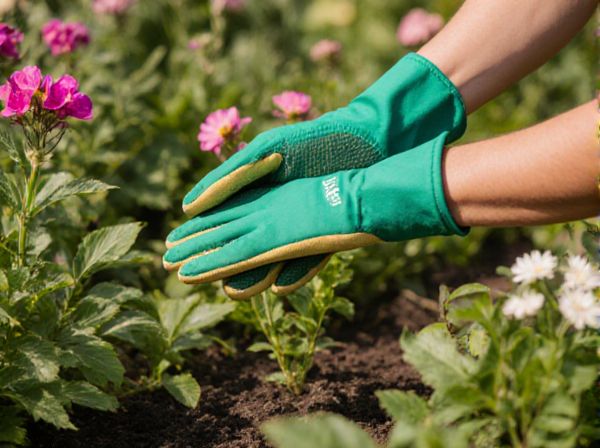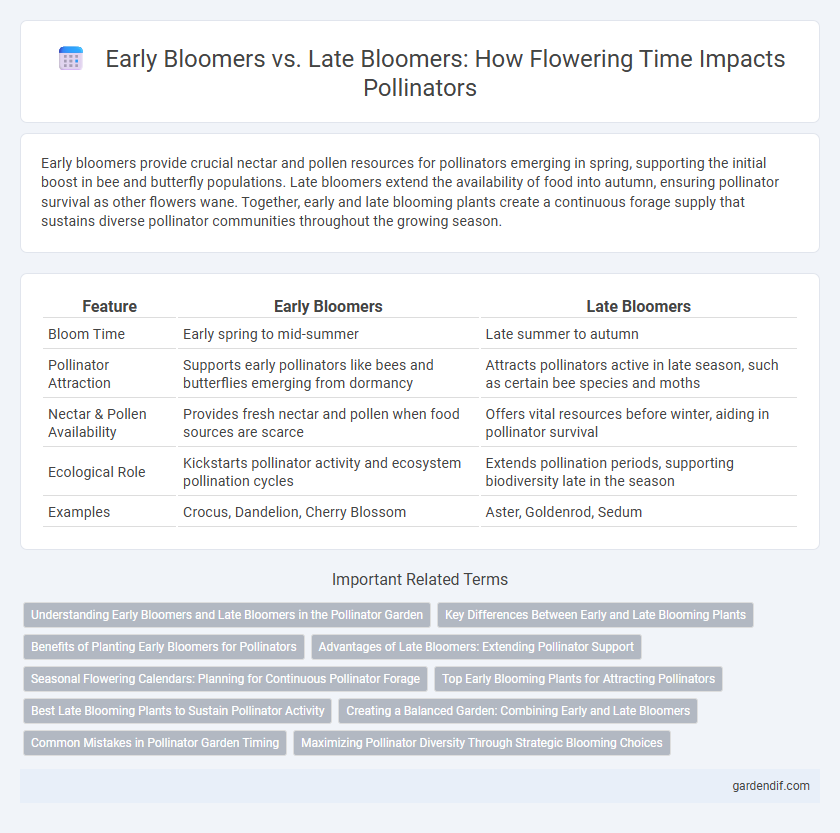
Early Bloomers vs Late Bloomers Illustration
Early bloomers provide crucial nectar and pollen resources for pollinators emerging in spring, supporting the initial boost in bee and butterfly populations. Late bloomers extend the availability of food into autumn, ensuring pollinator survival as other flowers wane. Together, early and late blooming plants create a continuous forage supply that sustains diverse pollinator communities throughout the growing season.
Table of Comparison
| Feature | Early Bloomers | Late Bloomers |
|---|---|---|
| Bloom Time | Early spring to mid-summer | Late summer to autumn |
| Pollinator Attraction | Supports early pollinators like bees and butterflies emerging from dormancy | Attracts pollinators active in late season, such as certain bee species and moths |
| Nectar & Pollen Availability | Provides fresh nectar and pollen when food sources are scarce | Offers vital resources before winter, aiding in pollinator survival |
| Ecological Role | Kickstarts pollinator activity and ecosystem pollination cycles | Extends pollination periods, supporting biodiversity late in the season |
| Examples | Crocus, Dandelion, Cherry Blossom | Aster, Goldenrod, Sedum |
Understanding Early Bloomers and Late Bloomers in the Pollinator Garden
Early bloomers in the pollinator garden provide crucial nectar and pollen resources during the early spring when pollinator activity begins to rise, supporting emerging bees and butterflies. Late bloomers extend the foraging season into late summer and fall, ensuring continuous food supply for pollinators preparing for overwintering or migration. Selecting a diverse mix of early and late bloomers enhances habitat quality and promotes pollinator health by offering a staggered succession of floral resources throughout the growing season.
Key Differences Between Early and Late Blooming Plants
Early blooming plants flower in late winter to early spring, providing crucial nectar and pollen for emerging pollinators when food sources are scarce. Late blooming plants flower in late summer to fall, supporting pollinators preparing for dormancy or migration by offering extended foraging opportunities. Differences include timing of resource availability, adaptation to specific pollinator species, and variations in flower morphology suited to different climatic conditions.
Benefits of Planting Early Bloomers for Pollinators
Planting early bloomers provides essential nectar and pollen resources for pollinators emerging from winter dormancy, supporting their energy needs and population growth. Early blooming flowers such as crocuses, snowdrops, and witch hazel offer critical food sources when late bloomers have yet to flower, enhancing habitat diversity and seasonal forage continuity for bees, butterflies, and other pollinators. This strategic planting promotes ecosystem stability and boosts pollinator health by bridging resource gaps during the crucial early spring period.
Advantages of Late Bloomers: Extending Pollinator Support
Late bloomers provide critical resources for pollinators by extending the availability of nectar and pollen well into the late season, supporting species such as bumblebees and monarch butterflies during periods of scarcity. Their prolonged flowering times help maintain pollinator diversity and resilience within ecosystems by bridging gaps left by early bloomers. This extended support is essential for sustaining pollinator populations, enhancing plant-pollinator interactions, and promoting overall ecosystem health.
Seasonal Flowering Calendars: Planning for Continuous Pollinator Forage
Seasonal flowering calendars highlight the importance of planting both early bloomers such as crocuses and snowdrops, and late bloomers like goldenrod and asters, to ensure continuous pollinator forage throughout the growing season. Early bloomers provide crucial nectar and pollen resources in spring when pollinator populations emerge, while late bloomers sustain them into fall, preventing forage gaps. Strategic selection and timing of these floral resources support diverse pollinator health and contribute to ecosystem stability.
Top Early Blooming Plants for Attracting Pollinators
Top early blooming plants for attracting pollinators include crocus, snowdrops, and hellebores, which provide essential nectar sources when few other flowers are available. These plants support early active pollinators like bumblebees and honeybees emerging from winter dormancy. Selecting native early bloomers enhances pollinator health and biodiversity by offering critical food resources during spring's first warm days.
Best Late Blooming Plants to Sustain Pollinator Activity
Late blooming plants such as goldenrod (Solidago spp.), asters (Symphyotrichum spp.), and joe-pye weed (Eutrochium purpureum) provide critical nectar and pollen sources for pollinators like bees, butterflies, and hummingbirds during late summer and fall. These species extend foraging opportunities when early bloomers have faded, supporting pollinator energy needs and reproduction before winter. Incorporating diverse late bloomers in gardens and natural habitats sustains pollinator populations and promotes ecosystem resilience.
Creating a Balanced Garden: Combining Early and Late Bloomers
Combining early and late bloomers in a garden ensures a continuous supply of nectar and pollen, supporting diverse pollinator species throughout the growing season. Early bloomers like crocuses and snowdrops provide essential resources in early spring when pollinators emerge from dormancy, while late bloomers such as goldenrod and asters sustain them into fall. This strategic planting promotes robust pollinator populations and enhances overall garden biodiversity.
Common Mistakes in Pollinator Garden Timing
Common mistakes in pollinator garden timing often involve planting early bloomers too late, missing critical early-season nectar sources for emerging pollinators. Conversely, planting late bloomers too early can lead to wasted resources and reduced bloom quality as these plants may struggle with colder conditions. Ensuring synchronized bloom periods tailored to local pollinator activity patterns enhances food availability and supports pollinator health effectively.
Maximizing Pollinator Diversity Through Strategic Blooming Choices
Early bloomers such as crocuses and snowdrops provide critical nectar sources for early-season pollinators like bumblebees emerging from hibernation. Late bloomers including goldenrods and asters extend forage availability into fall, supporting pollinators preparing for winter or migration. Strategically selecting a mix of early and late flowering plants maximizes pollinator diversity by offering continuous resources across varying pollinator activity periods.
Early Bloomers vs Late Bloomers Infographic

 gardendif.com
gardendif.com